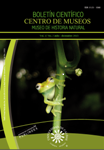Authors
Abstract
Objective: To compare and analyze the correlation between serum thyroid concentrations of 6 groups of horses (young females vs. young males; adult females vs. adult males; young females vs. adult females; young males vs. adult males; females vs. males, and young vs. adults). Materials and Methods: Blood samples were obtained from 99 horses in the fasting state, differentiated by gender and age (50 horses under two years: 25 females and 25 males, and 49 horses over two years: 25 females and 24 males). Levels of THS and free T4 were measured by enzymatic immunoassay. Results: For the FT4 by age group: significant difference for young vs. adults was found, with a p-value lower than 0.05 equal to 0.005, with 0.74 mg/dl and 0.59 mg/dl average ranks for young and adults respectively, with a confidence level of 95%. Similarly, statistically significant difference for young females vs. adult females was found in the FT4 fraction ranging from 0.74 mg/dl and 0.56 mg/dl respectively, with a p-value lower than 0.05 equal to 0.01. For the other groups, the differences in FT4 and TSH values ?? were not significant (P ≥ 0.05). Conclusions: The results suggest that young females present higher FT4 serum levels.
Keywords
References
BARAGLI, P. et al., 2011. Early evidence of the anticipatory response of plasma catecholamine in equine exercise. Equine Vet J., 31: 85-88.
BOOSINGER, T.R.; BRENDEMUEHL, J.P.; BRANSBY, D.L. et al. 1995. Prolonged gestation, decreased triiodothyronine concentration, and thyroid gland histomorphologic features in newborn foals of mares grazing Acremonion coenophialum-infected fescue. Am J Vet Res, 56, 66-9
BREUHAUS, B.A., 2011. Disorders of the Equine Thyroid Gland. Vet Clin North Am Equine Pract., 27 (1): 115-128.
BREUHAUS, B.A. & LAFEVERS, D.H. 2005. Thyroid function in normal, sick and premature Foals [abstract]. J Vet Intern Med, 19, 445.
BUFF, P.R. et al., 2007. Seasonal and pulsatile dynamics of thyrotropin and leptin in mares maintained under a constant energy balance. Domestic Animal Endocrinol., 33: 430-436.
CHRISTENSEN, R.A. et al., 1997. Acute effects of short-term feed deprivation and refeeding on circulating concentrations of metabolites, insulin-like growth factor i, insulin-like growth factor binding proteins, somatotropin, and thyroid hormones in adult geldings. J Anim Sci., 75: 1351-1358.
CROCKFORD, S.J., 2003. Thyroid rhythm phenotypes and hominid evolution: a new paradigm implicates pulsatile hormone secretion in speciation and adaptation changes. Comp Biochem Physiol AMol Integr Physiol., 135: 105-129.
DIVERS, J.T., 2008. Endocrine Testing in Horses: Metabolic Syndrome and Cushing's Disease. Equine Vet J., 28 (5): 315-316.
DONALD E.G. GRIESDALE, RUSSELL J. DE SOUZA, ROB M. VAN DAM. et al., 2008. Intensive insulin therapy and mortality among critically ill patients: a meta-analysis including NICE-SUGAR study data. CMAJ. 180(8): 821–827.
DOUGLAS, R. 1999. Circadian cortisol rhythmicity and equine cushing's-like disease. Equine Vet J, 19(11), 684, 750-751, 753.
DUCKETT WM. 1989. Thyroid gland. Equine internal medicine. 917–923.
FAZIO, E. et al., 2007. Total and free iodothyronine levels of growing Thoroughbred foals: Effects of weaning and gender. Livestock Science, 110 (3): 207-213.
FRANK, N. et al., 2002. Equine thyroid dysfunction. Vet Clin Equine, 18: 305-319.
FURR, M.O.; MURRAY, M.J. & FERGUSON, D.C. 1992. The effects of stress on gastric ulceration, T3, T4, reverse T3 and cortisol in neonatal foals. Equine Vet J, 24, 37-40.
HALLERMEIER KM , WU SM, STRATAKIS CA, CHAN CHY, BOURDONY CJ, RENNERT OM, et al., 1998. Genetic heterogeneity of adrenocorticotropin (ACTH) resistance syndromes: identification of a novel mutation of the ACTH receptor genein hereditary glucocorticoid deficiency. Mol Genet Metab., 64:256-65.
HULBERT, A.J., 2000. Thyroid hormones and their effects: a new perspective. Biol. Rev., 75: 519-631.
HURCOMBE, S.D., 2011. Hypothalamic-Pituitary gland axis function and disfunction in horses. Vet Clin Equine, 27: 1-17.
KRATZSCH, J. & PULZER, F., 2008. Thyroid gland development and defects. Best Pract Res Clin Endocrinol Metab., 22 (1): 57-75.
MEDICA, P. et al., 2011. 24-hour endocrine profiles of quarter horses under resting conditions. Equine Vet J., 31: 35-40.
MESSER, N.T. et al., 1998. Thyroid Hormone Levels in Thoroughbred Mares and Their Foals at Parturition. Proceedings of the Annual Convention of the AAEP, 44: 248-251.
TORIBIO, R.E., 2011. Endocrine dysregulation in critically ill foals and horses. Vet Clin North Am Equine Pract., 27 (1): 35-47.
TORIBIO, R.E. & DUCKETT, W.M., 2004. Equine Internal Medicine. Estados Unidos de América: Saunders.

 PDF (Español)
PDF (Español)
 FLIP
FLIP


















